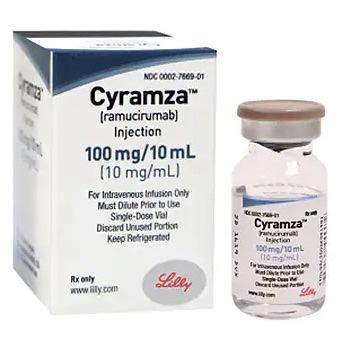Ramucirumab Side Effects
Medically reviewed by Drugs.com. Last updated on Aug 22, 2024.
Applies to ramucirumab: intravenous solution.
Serious side effects of ramucirumab
Along with its needed effects, ramucirumab may cause some unwanted effects. Although not all of these side effects may occur, if they do occur they may need medical attention.
Check with your doctor or nurse immediately if any of the following side effects occur while taking ramucirumab:
More common side effects
- back pain or spasms
- blurred vision
- burning, crawling, itching, numbness, prickling, "pins and needles", or tingling feelings
- chest pain
- chills
- cloudy urine
- confusion
- cough
- coughing up blood
- decreased urine output
- dizziness, faintness, or lightheadedness when getting up suddenly from a lying or sitting position
- fainting
- fast, slow, pounding, or irregular heartbeat or pulse
- feeling of warmth
- feeling unusually cold
- fever
- headache
- increased thirst
- lower back or side pain
- muscle pain or cramps
- nausea
- nervousness
- nosebleeds
- painful or difficult urination
- pounding in the ears
- redness of the face, neck, arms, and occasionally, upper chest
- seizures
- shakiness in the legs, arms, hands, or feet
- shivering
- sweating
- swelling of the face, hands, ankles, feet, or lower legs
- trembling or shaking of the hands or feet
- trouble breathing
- unusual tiredness or weakness
- vomiting
Less common side effects
- bleeding gums
- difficulty swallowing
- dizziness
- inability to speak
- increased menstrual flow or vaginal bleeding
- loss of consciousness
- low blood pressure or pulse
- pain in the chest, groin, or legs, especially calves of the legs
- pain or discomfort in the arms, jaw, back, or neck
- pale skin
- paralysis
- prolonged bleeding from cuts
- red or black, tarry stools
- red or dark brown urine
- severe constipation
- severe headaches of sudden onset
- severe numbness, especially on one side of the face or body
- slurred speech
- sore throat
- stomach pain, cramping, or burning
- sudden loss of coordination
- sudden onset of slurred speech
- sudden vision changes
- sweating
- temporary blindness
- ulcers, sores, or white spots in the mouth
- unusual bleeding or bruising
- vomiting of material that looks like coffee grounds, severe and continuing
Incidence not known
- full feeling and pain in the upper abdomen
- nausea
- sudden weakness in the arms or legs
- sudden, severe chest pain
Other side effects of ramucirumab
Some side effects of ramucirumab may occur that usually do not need medical attention. These side effects may go away during treatment as your body adjusts to the medicine. Also, your health care professional may be able to tell you about ways to prevent or reduce some of these side effects.
Check with your health care professional if any of the following side effects continue or are bothersome or if you have any questions about them:
More common side effects
For healthcare professionals
Applies to ramucirumab: intravenous solution.
Gastrointestinal adverse events
- Very common (10% or more): Diarrhea (32%), abdominal pain (29%), stomatitis (20%), mucosal inflammation, GI hemorrhage events (e.g., hemorrhage, diarrhea hemorrhage, gastric hemorrhage, hematemesis, hematochezia, hemorrhoidal hemorrhage, Mallory-Weiss syndrome, melaena, esophageal hemorrhage, rectal hemorrhage, upper GI hemorrhage) (10%)
- Common (1% to 10%): Intestinal obstruction
- Uncommon (0.1% to 1%): GI perforation[Ref]
Immunologic
- Common (1% to 10%): Anti-ramucirumab antibodies
- Uncommon (0.1% to 1%): Infusion related reactions, sepsis[Ref]
Dermatologic
- Common (1% to 10%): Rash, Palmar-plantar erythrodysesthesia syndrome[Ref]
Hematologic
- Very common (10% or more): Neutropenia (54%), leukopenia (34%), thrombocytopenia (13%)[Ref]
Nervous system
- Common (1% to 10%): Headache
- Rare (less than 0.1%): Reversible Posterior Leukoencephalopathy Syndrome (RPLS), hepatic encephalopathy[Ref]
Renal
- Very common (10% or more): Proteinuria (17%)[Ref]
Cardiovascular
- Very common (10% or more): Peripheral edema (25%), hypertension (25%)
- Common (1% to 10%): Arterial thromboembolic events[Ref]
Metabolic
- Very common (10% or more): Hypoalbuminemia (11%)
- Common (1% to 10%): Hyponatremia, hypokalemia, hypoalbuminemia[Ref]
Other
- Very common (10% or more): Fatigue/asthenia (57%), peripheral edema[Ref]
Respiratory
- Very common (10% or more): Epistaxis (31%)[Ref]
Local
- Common (1% to 10%): Infusion-related reactions[Ref]
Genitourinary
- Very common (10% or more): Proteinuria[Ref]
References
1. Cerner Multum, Inc. "UK Summary of Product Characteristics."
2. Cerner Multum, Inc. "Australian Product Information."
3. (2014) "Product Information. Cyramza (ramucirumab)." Eli Lilly and Company
More about ramucirumab
- Check interactions
- Compare alternatives
- Dosage information
- During pregnancy
- Drug class: VEGF/VEGFR inhibitors
- Breastfeeding
- En español
Patient resources
Other brands
Professional resources
Other brands
Related treatment guides
Further information
Ramucirumab side effects can vary depending on the individual. Always consult your healthcare provider to ensure the information displayed on this page applies to your personal circumstances.
Note: Medication side effects may be underreported. If you are experiencing side effects that are not listed, submit a report to the FDA by following this guide.

